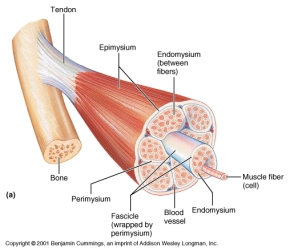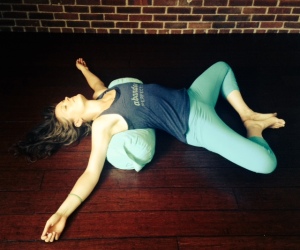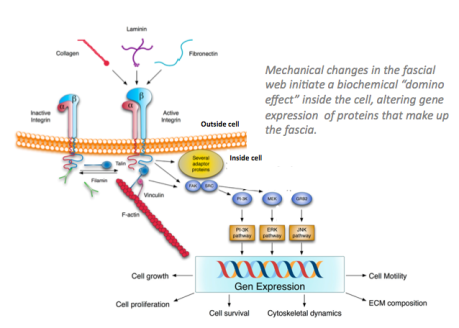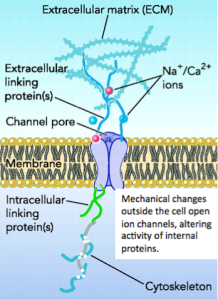How does the body sense yin postures?
In the previous blog post we took a look at why it is so important to exercise our connective tissues. But how can we accomplish this through yoga? Unfortunately, many people are under the assumption that active “yang” practices are an  adequate prescription. While it is true that yang practices can lengthen the muscle tissue that is deeply interwoven with the fascia (also known as epi/peri/endomysium), they do not provide the correct biomechanical environment to maximize fascial changes. Due to the interwoven nature of muscle and connective tissues, fascia will follow the movement of the muscle, contracting when the muscle contracts, and relaxing when the muscles relax.
adequate prescription. While it is true that yang practices can lengthen the muscle tissue that is deeply interwoven with the fascia (also known as epi/peri/endomysium), they do not provide the correct biomechanical environment to maximize fascial changes. Due to the interwoven nature of muscle and connective tissues, fascia will follow the movement of the muscle, contracting when the muscle contracts, and relaxing when the muscles relax.
A useful visual for this is to imagine a sheet of bubble wrap. When the air bubble is inflated, the material surrounding the air is stiff and provides strong, tensile support. However, if air is released from the bubble, space is created for the plastic material to move. Our muscle and fascia behave in a similar way; if our muscles are active, the fascia will experience tension directed toward the midline of the muscle. This tension creates an internal pull in the direction of the muscle contraction, thus shortening the fascia. However, if we relax our muscles while simultaneously holding a deep stretch, we remove any active, inward strain and allow passive, outward strain to drive the mechanotransduction (a process in which cells convert a mechanical signal into electrical and chemical changes, much like a windmill which coverts mechanical energy to electric power) of the local environment. This passive strain will produce tension longitudinally, allowing the fascia to lengthen, rather than the shortening tension which results from muscular engagement. For this reason, yin yoga emphasizes the absence of muscular engagement in the targeted area. When the musculature is soft and we place ourselves in yin postures that stretch, for example, the groin, the connective tissue surrounding the hip flexors will receive a signal that the biomechanical environment has changed. With this new information, biochemical changes can be initiated to adapt to the new environment.
our muscles while simultaneously holding a deep stretch, we remove any active, inward strain and allow passive, outward strain to drive the mechanotransduction (a process in which cells convert a mechanical signal into electrical and chemical changes, much like a windmill which coverts mechanical energy to electric power) of the local environment. This passive strain will produce tension longitudinally, allowing the fascia to lengthen, rather than the shortening tension which results from muscular engagement. For this reason, yin yoga emphasizes the absence of muscular engagement in the targeted area. When the musculature is soft and we place ourselves in yin postures that stretch, for example, the groin, the connective tissue surrounding the hip flexors will receive a signal that the biomechanical environment has changed. With this new information, biochemical changes can be initiated to adapt to the new environment.
So how does the connective tissue sense these changes on the cellular level? Research has suggested two primary  “middle men” which aid in this process. The first are proteins known as integrins which line the outer surface of cells. Integrins are classified as “transmembrane proteins” because half of their structure lies inside the cell and half lies outside the cell. Externally, integrins bind to other proteins such as laminins and tenacins, which are connected to a greater web of proteins that collectively move in unison to make up the fascia. These integrins form a fence which behaves much like the bungee-cord fences surrounding boxing rings. When there is a mechanical shift outside the cell in the fascia , the web of fascial proteins move the integrin fence, which then affects the internal mechanics of the cell. The intracellular proteins that dock to integrins will shift and initiate a biomechanical “domino effect” to alter gene expression patterns.
“middle men” which aid in this process. The first are proteins known as integrins which line the outer surface of cells. Integrins are classified as “transmembrane proteins” because half of their structure lies inside the cell and half lies outside the cell. Externally, integrins bind to other proteins such as laminins and tenacins, which are connected to a greater web of proteins that collectively move in unison to make up the fascia. These integrins form a fence which behaves much like the bungee-cord fences surrounding boxing rings. When there is a mechanical shift outside the cell in the fascia , the web of fascial proteins move the integrin fence, which then affects the internal mechanics of the cell. The intracellular proteins that dock to integrins will shift and initiate a biomechanical “domino effect” to alter gene expression patterns.
The second middleman between the external and internal environments of the cell that have been implicated are ion  channels. These can be imagined as gates whose opening is dependent on the local, electrical environment. When biomechanical forces are applied to fascia, a concurrent change in the electric charge of the area (known as piezoelectricity, which will be discussed in a later post) occurs. Changes in the charge of the fascia around cells cause ion channels to open, allowing an influx of electric charge into the cell in the form of positively charged ions. These ions alter protein activity inside the cell, which can initiate changes in gene expression as well.
channels. These can be imagined as gates whose opening is dependent on the local, electrical environment. When biomechanical forces are applied to fascia, a concurrent change in the electric charge of the area (known as piezoelectricity, which will be discussed in a later post) occurs. Changes in the charge of the fascia around cells cause ion channels to open, allowing an influx of electric charge into the cell in the form of positively charged ions. These ions alter protein activity inside the cell, which can initiate changes in gene expression as well.
Bringing this back to the bigger picture, our bodies are made up of countless interconnected proteins, which all work together to create an environment that is optimal for our habitual activities. Therefore, when we sit for extended periods of time, we ignite modifications in our fascia that are optimal for seated posture. Conversely, when we hold yin poses for extended durations, we are able to initiate changes which counteract the outcomes of sedentary lifestyle. These alterations are possible because the body speaks many languages and will translate the mechanical input of yin postures into biochemical and electrical outcomes. These chemical and electrical changes initiate a domino effect, setting in motion the process of fascial restoration. In the next and final post on the physiology of yin yoga, we will discuss just how these domino effects create beneficial changes in the fascia.

So much happening that we take for granted, yet so much our bodies and mind can partner to create positive outcomes!
LikeLike